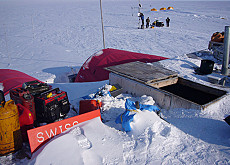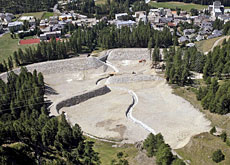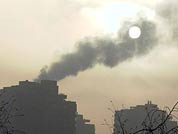Man “not to blame” for early carbon emissions

The question over who—or what—caused an increase in CO2 emissions thousands of years ago has dogged climatologists for years. Now Swiss scientists have an answer.
Some researchers have argued that ancient farmers could be to blame for a noticeable rise in greenhouse gases 6,500 years ago as they cleared primordial lands for agriculture.
As it turns out, man had nothing to do with it, scientists argue in Thursday’s issue of Nature.
The findings produced by researchers at the Bern-based Oeschger Centre for Climate Change Research and a polar institute in Bremerhaven, Germany, suggest that natural processes involving a growing biosphere and the sea released more carbon dioxide into the air after the end of the Ice Age.
Man’s measurable impacts on CO2 concentrations would not come until thousands of years later during the Industrial Age with its appetite for fossil fuel energy, said Thomas Stocker, a Bern climatologist and one author of the three-page report.
“We don’t directly contribute to the discussion about climate change as a natural cycle or whether what we see happening today is man-made,” Stocker told swissinfo.ch.
“The focus of the study is to investigate if man already left a measurable imprint in CO2 levels many of thousands of years ago.”
The answer is now clear: No.
Antarctic answers
It took a decade of work to get it. The study was a multinational effort that involved expeditions to Antarctica, reams of computer model data and a breakthrough combination of measuring techniques that allowed scientists for the first time to accurately quantify carbon isotopes trapped in ancient ice.
The researchers began by harvesting 199 ice cores from 59 different depths near a European-run Antarctic base on Dome C, a 3,233m-high region of the world’s largest, coldest desert, where summertime temperatures rarely rise above -25 degrees Celsius.
This pristine region of the Antarctic Plateau 1,100km inland is a treasure trove for scientists seeking prehistoric climatic data.
Stocker says scientists were interested in the types and amount of carbon dioxide entombed in bubbles found in the cores.
By studying the various forms and concentrations of carbon atoms, scientists could create a “fingerprint” of what was happening on Earth to produce carbon dioxide, the second most potent greenhouse gas after water vapour.
“It’s a very challenging measurement,” Stocker said, “but we now have a complete record over the last 11,000 years.”
The answer to the mystery of what had caused the Stone Age spike then boiled down to a relatively simple equation: If farming and land-clearing were to blame, bubbles in the ice would contain more of the carbon preferred by plants. They did not.

More
Carbon isotopes
Large, slow buffer
The Nature report – Stable isotope constraints on Holocene carbon cycle changes from an Antarctic ice core – points to a different culprit.
As the last vestiges of the Ice Age’s massive glaciers retreated, more vegetation began to grow. The increase meant a greater demand for carbon dioxide, which plants sucked from the atmosphere for photosynthesis. Air trapped in ice cores show this initial reduction in the greenhouse gas.
But the record then shows a notable increase in carbon dioxide emissions thousands of years later. The study says the oceans, not early farmers, were largely to blame.
“Oceans tend to reset whatever change you inflict upon the total carbon cycle. It’s a huge buffer,” Stocker said. “The response time is very slow, though. So this increase is actually the ocean taking over and releasing more gas.”
With the sea level rising, new corals could also grow. Reefs change the chemistry of the ocean in such a way that the sea releases more carbon dioxide.
Stocker says the findings answer a key question about humans and their role in changing in carbon levels in the atmosphere—at least from a long time ago.
“Our study can now conclusively show that man was not responsible for that part of the CO2 increase starting 6,000 years ago,” he said. “We are not talking about the present CO2 increase, which is much faster and much larger.”
Tim Neville, swissinfo.ch
The crux of Stocker’s study hinged upon studying air trapped in ice to determine ratios between the two types of stable carbon isotopes found in nature.
Carbon dioxide in the atmosphere is a mix of two types of carbon atoms, each of which can join with two atoms of oxygen to form the gas.
C12 is a lighter form of carbon and found in 99% of all carbon dioxide molecules. A heavier form of carbon, C13, has one more neutron than C12 and is found in about 1% of all carbon dioxide molecules.
Plants prefer C12 to C13. As plant life grows more abundant, the atmosphere has less C12, therefore increasing the concentration of C13 in the atmosphere.
By studying changes in the ratio between C12 and C13 trapped in air, soil, and tissues, scientists can piece together a picture of ancient conditions.

In compliance with the JTI standards
More: SWI swissinfo.ch certified by the Journalism Trust Initiative




You can find an overview of ongoing debates with our journalists here. Please join us!
If you want to start a conversation about a topic raised in this article or want to report factual errors, email us at english@swissinfo.ch.